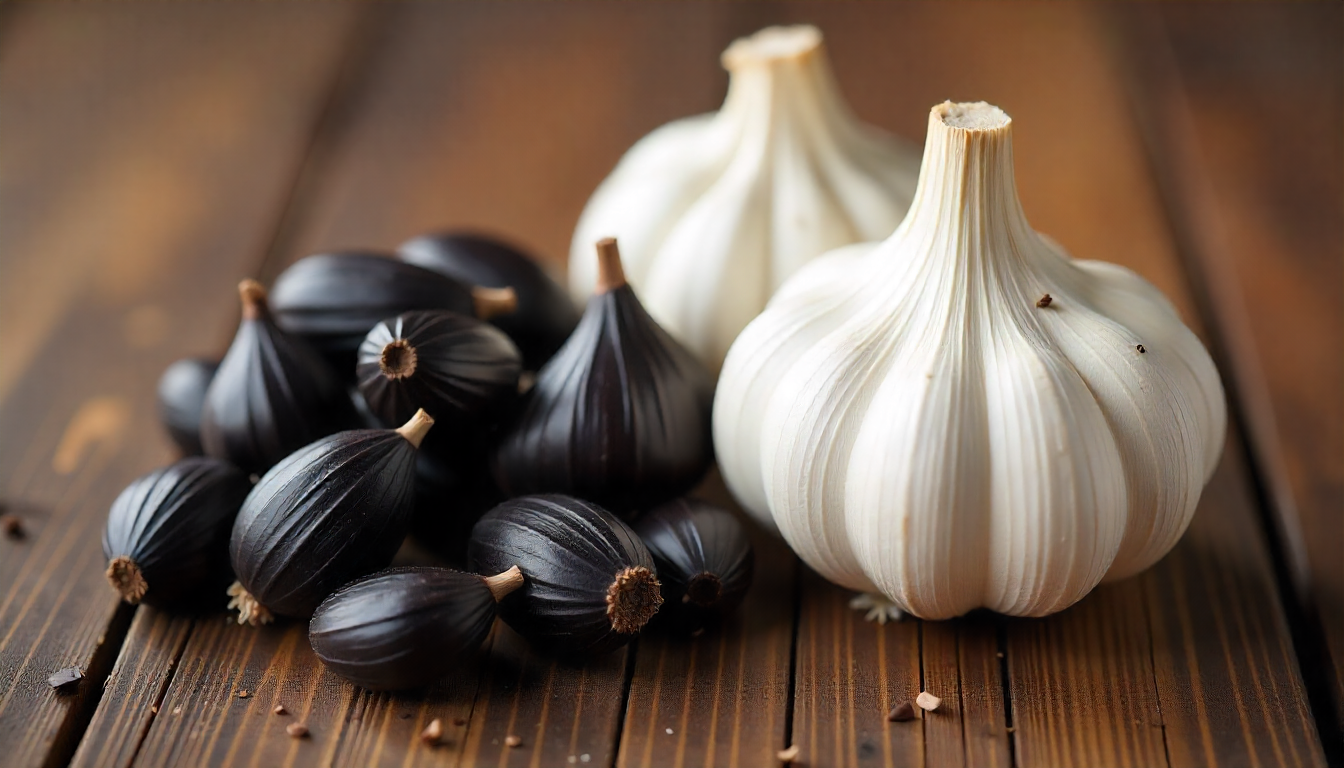Introduction: Garlic’s Importance in Health and Fitness Diets
Garlic (Allium sativum) has been a staple in human diets for millennia—not only for its pungent flavor, but also for its reputed health benefits. Fitness enthusiasts, nutritionists, and holistic healers often recommend garlic for its potential to support immune function, cardiovascular health, and metabolic well-being. In recent years, Black Garlic vs Regular Garlic has become a popular health comparison, as this unique fermented form of garlic is believed to offer even greater benefits than traditional (raw or cooked) garlic.
In this article, we explore Black Garlic vs Regular Garlic: Which One Is Healthier for You? We will delve into definitions, nutritional profiles, health benefits, applications in diet, implications for immunity, heart health, weight loss, and skin, and practical guidance on usage. By the end, you’ll be equipped to choose the garlic form best suited to your health goals.
Black Garlic vs Regular Garlic: What Is Black Garlic and How It’s Made (Fermentation / Aging Process)
Definition and Origin
Black garlic is essentially garlic (Allium sativum) that has undergone a controlled aging or fermentation process under heat and humidity for an extended period. Over time, the cloves turn dark brown to black, develop a soft, sticky texture, and acquire a milder, sweet-savory (umami) taste.
Although its precise origin is debated, black garlic has been used in parts of Asia (especially Korea, Japan, and Thailand) for centuries and has only recently become popular in Western health food and gourmet circles. (WebMD)
Black Garlic vs Regular Garlic: Fermentation / Aging Procedure
The process transforms raw garlic through controlled aging or “fermentation-like” reactions (though it’s not always a microbial fermentation in the strict sense). The usual steps include:
- Controlled temperature and humidity: Garlic bulbs or peeled cloves are kept in an environment (e.g., ~60–90 °C or ~140–190 °F, and humidity of ~70–90%) for multiple days to weeks (commonly 30–60 days).
- Maillard reaction: The browning and flavor development arise from non-enzymatic Maillard reactions (interactions of amino acids and reducing sugars) rather than microbial fermentation. These reactions gradually convert sulfur compounds and reduce pungency.
- No additives required: Generally, no artificial chemicals or preservatives are added—only time, humidity, and temperature.
After processing, the cloves are soft, dark, and flavorful with a “date-like” or molasses-like sweetness, lacking the harsh pungency and odor of raw garlic.
The transformation also affects the chemical composition, converting some unstable, volatile sulfur compounds (e.g., allicin) into more stable molecules (e.g., S-allylcysteine) and increasing antioxidant levels.
In short, black garlic is “aged” garlic with altered taste, texture, and nutrient profile.
Black Garlic vs Regular Garlic: Nutritional Differences Explained
To compare black garlic vs regular garlic, let’s examine how fermentation/aging affects their nutritional and phytochemical profiles.
Raw (Regular) Garlic: Key Nutrients & Bioactive Compounds
Raw garlic contains:
- Sulfur compounds: When raw garlic is chopped or crushed, the enzyme alliinase converts alliin to allicin, which contributes to garlic’s pungent odor and many of its health effects.
- Vitamins & minerals: Moderate amounts of vitamin C, vitamin B6, manganese, selenium, calcium, potassium, and trace minerals.
- Antioxidants & flavonoids: Quercetin, flavonoid compounds, phenolics, etc.
- Enzymes & amino acids: Various sulfur-containing amino acids and enzymes are present in raw tissue.
However, much of the allicin is unstable and degrades with heat, storage, or processing.
Black Garlic vs Regular Garlic: Altered Composition
Thanks to the aging process:
- Increased antioxidants: Many studies show that black garlic has significantly higher levels of antioxidants (e.g., total polyphenols, flavonoids) compared to raw garlic.
- Higher S-allylcysteine (SAC): The aging process yields more stable sulfur compounds like SAC, which is more bioavailable and less odorous than allicin.
- Reduced allicin and volatile sulfur compounds: Because of heat and prolonged reactions, much of the allicin content declines, and pungency is reduced.
- Amino acids and minerals: Some studies report modest increases in free amino acids and minerals due to the breakdown of proteins.
- Lower vitamin C: As vitamin C is heat-sensitive, black garlic tends to have lower vitamin C content than fresh garlic.
Thus, black garlic trades off pungent sulfurous compounds (like allicin) for a richer array of stable antioxidants and milder flavor.
Black Garlic vs Regular Garlic: Comparative Table (Simplified)
| Component / Trait | Regular (Raw) Garlic | Black Garlic |
|---|---|---|
| Allicin / volatile sulfur | High (when crushed raw) | Much reduced |
| S-allylcysteine (SAC) | Low | Higher |
| Slight increases in some amino acids/minerals | Moderate | Significantly higher |
| Vitamin C | Higher | Lower (degraded by heat) |
| Minerals & amino acids | Baseline amounts | Mild, sweet, with less odor |
| Odor & pungency | Strong, “garlicky” | Mild, sweet, less odor |
| Taste & texture | Crisp, pungent | Soft, sticky, umami-sweet |
In summary, black garlic tends to have greater antioxidant potential, but raw garlic retains strong sulfur compounds (allicin) that may have unique health actions.
Black Garlic vs Regular Garlic: Health Benefits Compared
Given its enriched antioxidant and stable sulfur compound profile, black garlic is credited with multiple beneficial effects. While many studies are preliminary or in animals, here is a summary of the key purported benefits.
Black Garlic vs Regular Garlic: Antioxidant & Anti-Inflammatory Effects
Black garlic’s high polyphenolic content enables it to neutralize free radicals, reduce oxidative stress, and suppress inflammatory pathways.
By reducing pro-inflammatory cytokines, black garlic may mitigate chronic inflammation, which underlies many modern diseases (cardiovascular disease, diabetes, neurodegeneration).
Black Garlic vs Regular Garlic: Cardiovascular & Lipid Benefits
- Cholesterol and lipid profile: Some human and animal studies suggest black garlic can help reduce LDL (bad cholesterol), total cholesterol, and triglycerides, while increasing HDL (good cholesterol).
- Improving endothelial function: In clinical trials, black garlic consumption improved measures of endothelial (blood vessel) function and reduced atherogenic indices.
- Blood pressure control: Some animal studies and limited human trials indicate potential for modest blood pressure reduction.
Overall, black garlic may support cardiovascular health via antioxidant, anti-inflammatory, lipid-lowering, and vasodilatory effects.
Glycemic Control & Metabolism
Black garlic may help regulate blood sugar and improve insulin sensitivity. Some studies in diabetic or high-fat diet animals show that black garlic extract reduced fasting glucose and insulin markers.
By reducing oxidative stress in pancreatic tissues it might protect beta-cell health.
Anti-Cancer & Cellular Protection
Laboratory and animal studies indicate that black garlic and its bioactive compounds (e.g., SAC, polyphenols) may:
- Induce apoptosis (programmed cell death) in cancer cells
- Suppress proliferation and angiogenesis (new blood vessels feeding tumors)
- Reduce DNA damage and tumor initiation
- Modulate immune surveillance against cancer cells (PMC)
However, these effects are largely preclinical; human evidence is still limited.
Neuroprotection & Brain Health
By reducing neuroinflammation and oxidative damage, black garlic may help protect against neurodegenerative diseases (e.g., Alzheimer’s, Parkinson’s). Some animal studies report improved memory and decreased brain stress markers.
Liver and Organ Protection
Black garlic has been shown in animal models to reduce liver enzyme markers (ALT, AST), protect against chemically-induced liver injury, and reduce fat accumulation in liver tissue.
Anti-Obesity & Weight Management
Some preclinical studies suggest black garlic may modestly inhibit fat accumulation, improve lipid metabolism, and blunt weight gain in high-fat diet models.
Also, by improving metabolic efficiency, it can assist in weight maintenance. However, black garlic is not a magic bullet; diet and activity remain central.
Skin & Anti-Aging
Because of its antioxidant and anti-inflammatory properties, black garlic may help protect skin cells from oxidative damage, support collagen health, and promote a youthful appearance. The reduced pungency and odor make it a more tolerable choice for topical or dietary use with skin goals.
Immune Support
Black garlic may boost immune function by modulating oxidative stress, reducing inflammation, and enhancing protective cellular mechanisms. It may improve resistance to infections and support immune balance.
Safety & Side Effects
Black garlic is generally considered safe at dietary levels. However:
- Because it still contains sulfur compounds that can thin blood, it may increase bleeding risk when combined with anticoagulant drugs.
- Allergic reactions are possible (same as for garlic).
- Overconsumption may cause mild gastrointestinal discomfort, gas, or odor.
- People with garlic sensitivity or those preparing for surgery should consult with a physician prior to heavy use.
In sum, black garlic offers a compelling array of health benefits, many of which build on, or improve upon, those of regular garlic.
Health Benefits of Regular Garlic
Raw or cooked garlic also offers many well-established health advantages, some of which complement or differ from black garlic’s profile. Below is a summary:
Antibacterial, Antiviral & Immune Effects
Raw garlic’s allicin exhibits broad-spectrum antimicrobial properties against bacteria, viruses, fungi, and parasites. This may help fight infections and modulate immune response.
Cardiovascular Benefits
- Blood pressure: Multiple meta-analyses have found that garlic supplementation can lead to modest reductions in systolic and diastolic blood pressure, especially in hypertensive individuals.
- Lipid-lowering: Garlic has been shown to reduce total cholesterol, LDL, and triglycerides to some extent.
- Anti-atherosclerosis effects: By inhibiting platelet aggregation, reducing oxidation, and improving endothelial function.
Detoxification & Heavy Metal Protection
Raw garlic’s sulfur compounds (e.g., diallyl disulfide) may support detoxification pathways and protect organs from heavy-metal toxicity, such as lead or arsenic.
Anti-Cancer Effects
Research has linked garlic consumption with reduced risks of certain cancers (e.g., stomach, colorectal, esophageal). The mechanisms include modulation of carcinogen activation, induction of apoptosis, and inhibition of tumor growth.
Digestive and Gut Benefits
Garlic may stimulate digestive enzymes, promote gut motility, and exert prebiotic effects (feeding beneficial gut bacteria).
Brain & Cognitive Health
By reducing oxidative stress and inflammation, garlic may help protect against cognitive decline and neurodegenerative diseases.
Weight & Metabolic Regulation
Some studies show garlic may modestly support weight loss or prevent fat accumulation through enhancing metabolism, reducing fat cell growth, or regulating appetite.
Skin & Anti-Aging
Garlic’s antioxidant compounds help neutralize free radicals, which can slow skin aging and maintain skin health. Some people also use garlic topically (with caution) for its antimicrobial or anti-inflammatory effects.
Safety & Limitations
- Raw garlic can cause strong breath odor, body odor, and gastrointestinal upset in some individuals.
- At high doses, garlic may interfere with medications (especially anticoagulants, antiplatelet agents, HIV drugs, etc.).
- Some people have garlic allergies.
- Very high intake may cause liver stress or irritate the digestive tract.
Thus, garlic (in its traditional forms) retains many potent health virtues, especially around antimicrobial action and cardiovascular support.
Black Garlic vs Regular Garlic — Which Is Better for Immunity, Heart, and Skin?
Let’s compare black garlic vs regular garlic in key health domains:
Immunity
- Regular garlic: Thanks to allicin and sulfur compounds, raw garlic offers strong antimicrobial and immune-stimulating effects.
- Black garlic: With improved antioxidant capacity and less pungency, black garlic offers immune support with less irritation.
Verdict: For acute immune defense (infection control), raw garlic may have an edge. For long-term immune balance, black garlic is an excellent, more tolerable alternative.
Heart & Cardiovascular Health
- Regular garlic: Can reduce blood pressure, support endothelial health, and lower cholesterol modestly.
- Black garlic: Enhances antioxidant protection, often shows stronger effects in human and animal trials of lipid modulation, endothelial function, and vascular health.
Verdict: Black garlic may be slightly more favorable for long-term heart health thanks to its enriched antioxidant profile, though raw garlic is still beneficial in classic cardiovascular support.
Skin Health & Anti-Aging
- Regular garlic: Contributes via antioxidant and anti-inflammatory actions.
- Black garlic: With higher polyphenolics and milder taste/odor, might be easier to include in diets and skincare routines with better tolerability.
Verdict: Black garlic may win in practical usage for skin goals.
Weight Loss / Metabolic Health
- Regular garlic: Supports metabolism, reduces fat cell formation, and aids circulation.
- Black garlic: Shows promising results in animal models regarding fat reduction, insulin sensitivity, and metabolic balance.
Verdict: Both help, but black garlic may provide a more refined metabolic support in modern diets. However, neither can replace calorie balance and exercise.
Overall: Which to Prefer When?
- Use regular garlic when you want a strong antimicrobial or immune boost (e.g., in colds or infections).
- Use black garlic daily or frequently for sustained antioxidant support, heart health, skin well-being, metabolic balance, and a gentler taste.
In practice, both can complement one another—raw garlic for occasional potent effects, black garlic for regular dietary support.
Black Garlic vs Regular Garlic: How to Use Both in Your Daily Diet
Here are practical ways to include both types of garlic in your meals, timing suggestions, portion ideas, and considerations:
Using Regular (Raw) Garlic
- Crush or chop fresh and let rest for 5–10 minutes before cooking to maximize allicin formation.
- In salad dressings, salsas, and dips: use raw garlic in small amounts (½–1 clove) blended into olive oil, lemon, and herbs.
- Lightly sauté or stir-fry (short-duration cooking) to retain some of its bioactives.
- Timing: On an empty stomach (morning), some prefer to take raw garlic for best absorption, but this may cause indigestion in sensitive people.
- Dosage guideline: Traditional suggestions often range from 1 to 4 cloves per day (depending on tolerance).
- Combine with foods like honey or yogurt to moderate pungency.
Using Black Garlic
- Whole cloves: eaten directly as a snack (peel and chew).
- Paste / Puree: mash or blend cloves into sauces, spreads, dressings, and marinades.
- In soups, stews, and risottos, stir in black garlic toward the end for flavor and health benefits.
- On bread, pizza, and dips: spread a thin layer of black garlic paste.
- Salad dressings/vinaigrettes: mix black garlic with vinegar, oil, and mustard.
- Timing: Use during the day or evening; it is mild and generally well tolerated.
Combining Them
You can use a small amount of raw garlic occasionally for a potent stimulus, while making black garlic your daily “go-to” for steady antioxidant and health support. For example:
- Morning: Raw garlic + lemon water
- Main meals: Add black garlic paste to sauces or dressings
- Snacks: Black garlic spread on toast or in smoothies
Quantity & Safety
- Dietary levels (1–3 cloves of black garlic or 2–4 cloves of raw garlic per day) are generally safe for healthy individuals.
- Start slowly (½ clove equivalent) to assess tolerance.
- Avoid excessive use, especially if you take blood thinners or have gastrointestinal sensitivity.
Final Verdict — Black Garlic vs Regular Garlic: Which Should You Choose for Better Health?
Summary
- Regular (raw) garlic excels in delivering allicin and strong antimicrobial, immune-stimulating effects.
- Black garlic shines in its enhanced antioxidant content, milder taste, and greater tolerability.
- For cardiovascular, metabolic, skin, and long-term health support, black garlic may be the better everyday choice.
- For acute immune challenges or when you need a potent antimicrobial boost, regular garlic has unique benefits.
- They are complementary—using both in different contexts maximizes your benefits.
Weight Loss & Time of Use
- Neither garlic type is a magic bullet for weight loss—but black garlic has shown more favorable effects in fat reduction and metabolism in animal studies.
- Use black garlic regularly with meals to support your metabolic function.
- Use raw garlic sparingly (e.g., morning or on an empty stomach) if your digestion tolerates it, for a “metabolic stimulus.”
- Important: weight loss depends primarily on calorie deficit, exercise, sleep, and overall nutrition. Garlic supports, but does not substitute for these foundations.
Black Garlic vs Regular Garlic: Frequently Asked Questions
Q1: Can black garlic completely replace raw garlic?
A: In many circumstances, yes—black garlic offers a milder flavor and good health support. But for strong antimicrobial or “detox” needs, raw garlic may add unique benefits. Many users adopt a hybrid approach.
Q2: Does black garlic cause bad breath?
A: Much less so than raw garlic. After fermentation, many malodorous sulfur compounds are reduced, so black garlic is far less likely to cause strong garlic breath. (WebMD)
Q3: How much black garlic should I take daily?
A: A typical range is 1–3 cloves per day (or equivalent in paste or powder). Supplements may provide higher concentrations—always follow label instructions and consult a healthcare provider if you have health conditions.
Q4: Can I take black garlic or garlic supplements if I’m on blood thinners?
A: Use caution. Garlic (either raw or black) can potentiate bleeding risks when combined with anticoagulants. Consult your physician before use. (WebMD)
Q5: Which is better for skin and beauty?
A: Black garlic has an advantage because of its abundant antioxidants and milder taste/odor, making it easier to include in dietary or cosmetic uses.
Q6: Are there side effects?
A: In moderate amounts, side effects are rare but may include mild GI upset, gas, garlic odor, and potential interaction with medications (especially anticoagulants). Allergic reactions are possible.
Q7: Can I make black garlic at home?
A: Yes. With a controlled environment (warm temperature, high humidity over many days), you can “age” garlic to create black garlic. But it requires precision to avoid spoilage or microbial contamination. Many people prefer to buy it ready-made.
Conclusion: Which Is Healthier — Black Garlic vs Regular Garlic?
Give black garlic a try in your diet for a few weeks and notice how it impacts your energy levels, digestion, skin health, and immunity. For best results, pair it occasionally with raw garlic to enhance its natural potency and detox benefits.
For readers who want to dig deeper into the science, explore trusted health sources such as WebMD for general garlic benefits or PMC / NCBI for detailed research on black garlic — including the review “Black Garlic and Its Bioactive Compounds on Human Health Diseases.”
Call to Action
If you’re intrigued by the health potential of black garlic, now’s the perfect time to experience its unique benefits for yourself. You can easily find it in a few convenient forms — ideal for cooking, daily supplements, or quick meal prep:
Black Garlic Bulbs — Whole fermented bulbs for rich flavor and nutrients.
Black Garlic Capsules / Supplements — Perfect for a daily antioxidant boost.
Black Garlic Paste or Puree — Effortlessly mix into sauces, soups, or marinades.
Minced Organic Garlic in a Jar — Great for those who prefer raw garlic convenience.
Amazon Affiliate Disclosure
As an Amazon Associate, I earn from qualifying purchases. This helps support FitFusionBlogs so we can continue providing free, research-based health and fitness content — at no extra cost to you.
Explore more healthy eating tips on FitFusionBlogs.com — check out related articles:
- Gut Cleansing Foods
- Worst Foods for Your Kidneys
- Apple Fruit Benefits
- Healthy Snack Ideas for Weight Loss
For more wellness insights, also explore Healthline.com — one of the most trusted health websites for nutrition research and fitness guides.



